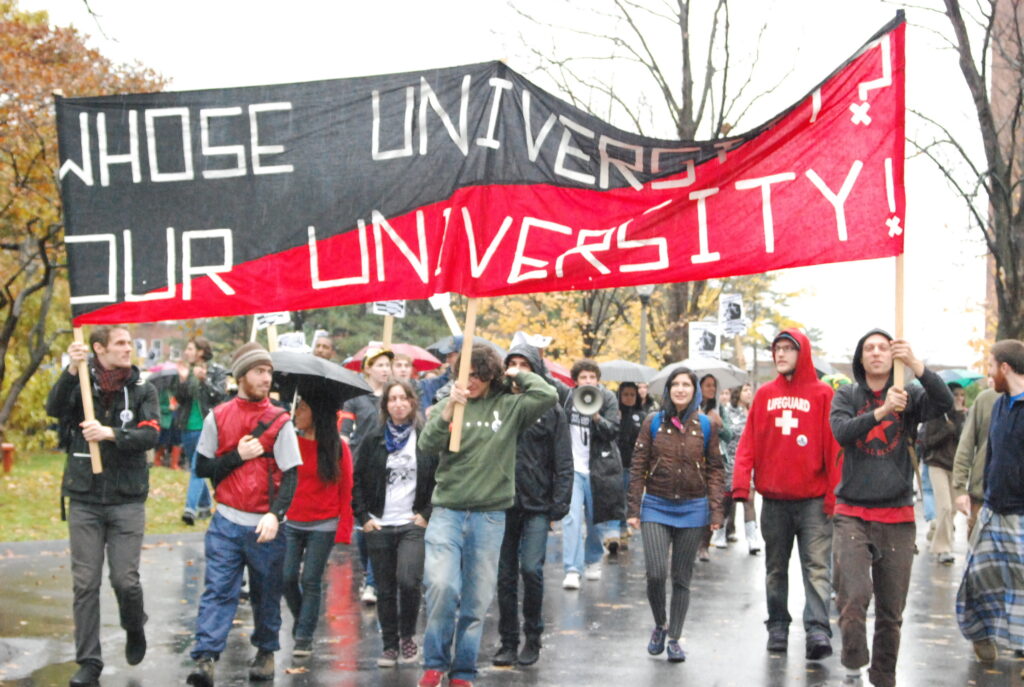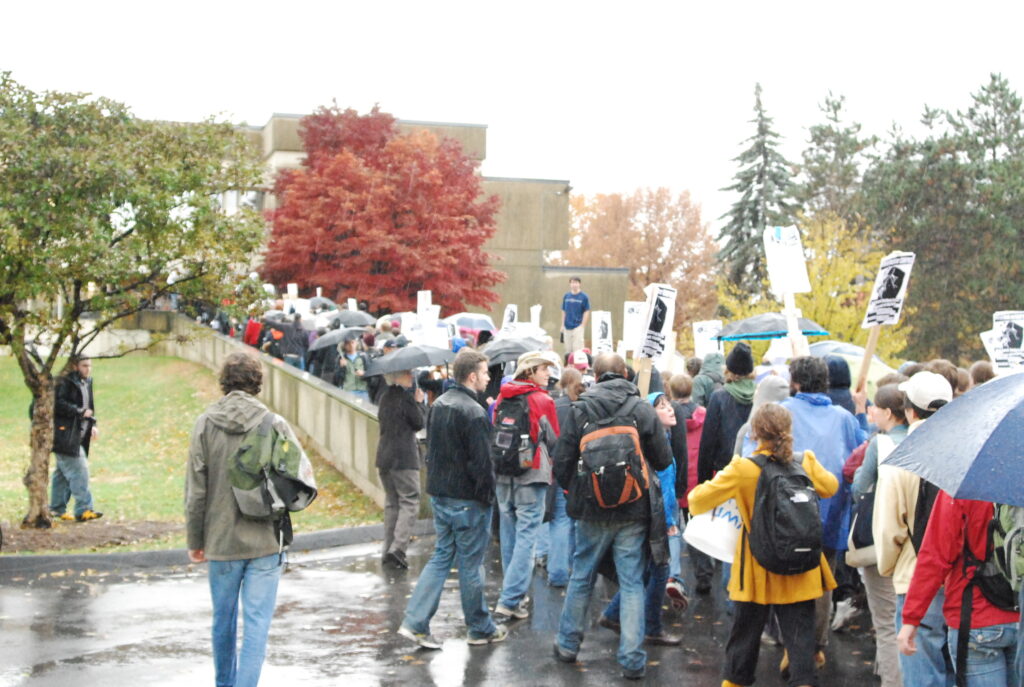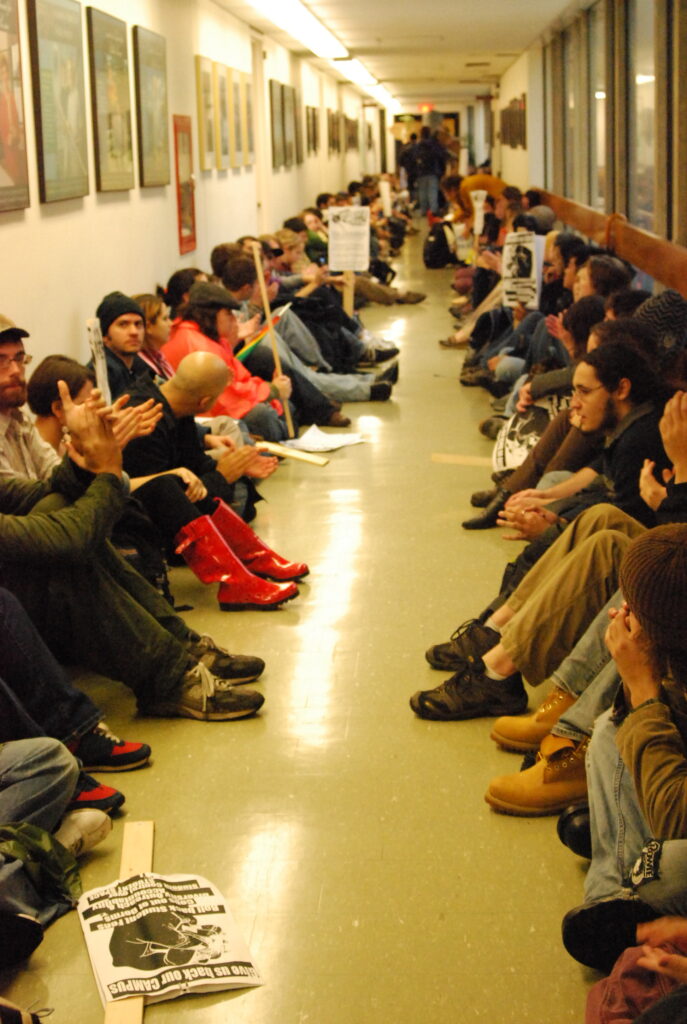Opinion: UMass Chancellor Reyes’ Police Action Was Unnecessary and Unprecedented. A Brief History of Dissent At UMass Amherst

Scenes from the 2007 UMass Student Strike. Students marched to the Whitmore Administration Building following a rally at the Student Union on November 15, 2007. Photo: UMass Student Goverment Association
Note: the following analysis draws substantially from the blog Radical UMass that was started around 2010 by the late UMass sociology professor Dan Clawson. Several of the detailed accounts in that blog were produced for a class Clawson taught in 2011 entitled Radical Movements. Clawson and his students have left us an important, albeit incomplete, archive on progressive political action at UMass and their project may helpfully inform the work of current campus activists.
The column below focuses on the use of police to constrain political speech or action on campus and does not address sports-related riots, the most notorious of which was the racially charged 1986 World Series riot. According to the Massachusetts Daily Collegian, since then there have been at least six additional sports riots at UMass resulting in property damage, injury, and police intervention.
In reviewing the history of protest on the UMass campus, the actions of Chancellor Javier Reyes stand out as extreme and out-of-proportion to the actions of students. There have indeed been a handful of arrests in the history of UMass activism, but these are exceptions to a long record of school administrators addressing campus dissent through negotiation. And Reyes’ use of police violence to silence political speech appears to be unprecedented.
There have been several building occupations between 1960 and 2016 of which only a few resulted in arrests and, as far as the record indicates, none resulted in convictions or suspensions. There have been at least 15 of these since I arrived on campus in 1979 and while my memory is fading, my recollections, along with the written records, suggest that none of those resulted in violent encounters between students and law enforcement. While there were indeed calls from administrators to arrest occupying students and forcibly end some of these occupations, in each instance, university administrators negotiated with students–albeit often grudgingly – a process that nearly always resulted in settlements that met several student demands and that benefitted the campus as a whole. The tense but fruitful process of engagement and resolution with militant students stands in sharp contrast to Reyes’ over-reaction to a group of students peacefully occupying a patch of campus lawn while engaging in a lot of mutual teaching and learning – a purported purpose of the university.
There is much to be gleaned from the histories of activism at UMass but here I just want to make two points. First, the violence of Reyes’ police intervention is unprecedented. Leaders in the past have seen no need to call in the police to forcibly silence student dissent throughout the long and rich history of campus activism. Second, negotiating with student activists, as just noted, can benefit the entire campus, although sometimes administrators reneged on agreements they had made.
Arrests and Police Violence.
In my 45 years at UMass (active and retired) I can recall only one instance of police being on campus in riot gear and that was to quell the 1986 World Series riot. That was a true riot with Red Sox and Mets fans (and white and Black students) attacking each other (as well as attacking fire and law enforcement personnel) with baseball bats. Students were burning furniture and setting it ablaze, so this was clearly not an effort to constrain political speech. It was a dangerous situation. According to Tyler Poisson, writing in last week’s Indy, that riot produced eight arrests. Contrast this with the violent arrest of 134 UMass students, faculty and local residents for “violating the campus land use policy” by peacefully occupying a piece of lawn without a permit, or for bearing witness to police violence during the arrests. Bystanders and witnesses were charged with trespassing and/or disturbing the peace and/or resisting arrest and were themselves violently arrested.
According to the Radical UMass Blog there were also arrests in 1986, 1987, and 1989. But the building occupations of 1992, 1997, 2007, and 2016, which involved more than two weeks of occupations of university buildings by hundreds of students (and at least in the case of 1992 and 1997, members of the UMass faculty), did not result in a single arrest And each of these occupations produced negotiations and settlements that addressed the problems that led to the occupations. There were no suspensions, expulsions, bannings, or sanctions and each agreement resulted in a commitment to more purposeful communication between students and the administration. Indeed, the conclusion of the administration following the 1997 occupation was that there needed to be better lines of communication between the administration and students and faculty. It wasn’t utopian by any means. University administrators sometimes failed to abide by agreements they made. And they established a restrictive picketing code that students proceeded to violate in the actions of subsequent years. And administrators adopted rules that constrained free speech such as a ban on sidewalk chalking and a requirement to get flyers approved before they could be posted in many campus venues. Violations of the picketing code resulted in threats of arrest or suspension. But those threats were not enacted.

A Brief History of Dissent at UMass
In the brief history that I summarize below I focus on building occupations which are substantial acts of civil disobedience in direct violation of campus rules, that were nonetheless not met with draconian reactions from campus administrators.
1969: African-American students occupied the George Mills House dormitory to protest violence, and threats of violence against them. Shortly thereafter, George Mills House became New Africa House, which stands to this day as a campus nexus for African American learning, culture, and solidarity.
1970: Students occupied the campus ROTC building, apparently as part of the national student strike in response to the killing of student protestors at Kent State. That action resulted in an agreement to abolish ROTC at UMass though the policy was rescinded a year later.
1978: Female students occupied the offices of the Daily Collegian to protest the absence of coverage of women’s issues in the paper.
1986: a small group of student activists conducted a persistent campaign that convinced the UMass Board of Trustees to divest from South Africa in response to apartheid. Students engaged in multiple presentations to the UMass Board of Trustees on the horrors of apartheid and the benefits of divestment. The campaign also included several sit-ins – one of which resulted in arrests “because it prevented the conduct of university business” while other sit-ins were allowed to continue “because they allowed university business to continue.” Several students were arraigned on a variety of charges but eventually all charges were dropped.
1986-87: 68 people were arrested for occupying a building while protesting CIA recruiting on campus. Most were UMass students and among the others was Amy Carter, the daughter of former US President Jimmy Carter. They were charged and tried. Luminaries of the anti-war movement including Howard Zinn, Daniel Ellsberg, and several former CIA agents testified in their defense and they were all acquitted.
1989: Concerned about the militarization of higher education, the student organization People for a Socially Responsible University (PSRU) organized several non-violent protests. Over the course of six sit-in occupations of UMass campus buildings in the spring of 1989, around 200 students were arrested. The UMass administration refused to acknowledge PSRU. Nonetheless the group was involved in issues including budget cuts, school investment policy, economic conversion, and environmentalism. PSRU continued to be active until 1992.
1989: There was a one-week student strike to protest tuition increases,rising student debt, and shrinking state appropriations for higher education. Thousands of students participated in boycotting classes and daily rallies, with 4000 participating in a march on the final day of the strike. These actions foreshadowed the activism to come over the rising cost of higher education.
1992: ALANA (African American, Latinx American, Asian American and Native American) students took over the Whitmore Administrative building for eight hours in support of racial justice on campus and also in response to the frustrating Rodney King verdict. Their main concerns included lack of faculty and students of color, absence of support programs, and inadequate retention rates. Their actions produced an agreement with the administration concerning hiring and admissions including an agreement to hire 10 people of color over the next three years at an estimated cost of $350,000.
1997: More than 150 people, including some faculty, occupied Goodell Hall for six days beginning with the Controller’s Office and eventually taking over the entire building, demanding the administration do more to promote diversity and specifically, that the administration abide by the agreement that resulted from the 1992 building occupation. The protestors won most of their demands, there were no arrests, and the settlement included amnesty for all occupiers.
2007: Undergraduate students, with the support of a broad coalition of graduate students and faculty, went on strike for a week and occupied Whitmore for a day, seeking relief from escalating costs of an education at UMass and making demands to get police out of the dormitories. The occupation resulted in a year of negotiating sessions with the chancellor, and won concessions on most of their demands. There were no arrests or sanctions against striking/occupying students.
2016: More than 200 UMass students demanding that the university divest from fossil fuels, occupied Whitmore for a week while hundreds of supporting students rallied daily outside the occupation (see also here). The campaign ended with the UMass Trustees voting to endorse divestment from fossil fuel companies and developing a public timeline for doing so.

Reyes Out of Touch With Campus Culture and History
I have to wonder if Chancellor Reyes is aware of this history on this campus – and the cultural legacy with which he is so out of sync. I wonder if he, or those directing his actions, believe that he/they can punish students into silence and submission. There’s certainly no evidence that such efforts have succeeded in the past on most American college campuses. The history of dissent and of advocacy for justice at UMass and at many other campuses over the last 60 years since the beginning of the Free Speech Movement, suggests that this authoritarian approach is fruitless. Our campus history, and the history of other activist campuses like Columbia, Wisconsin, and Cal Berkeley shows that as campus administrators put the screws on free speech and engage in increasingly oppressive tactics, students’ aspirations for freedom of expression grow and more students turn out to engage in political action, strengthening the movements.
Reyes does appear to have succeeded in unifying the UMass student body along with faculty and other campus workers and to have exhausted the reservoir of political capital that he was granted when he arrived. In spite of receiving strong statements of support from the system president, the board of trustees, and the governor, he now has little credibility with folks on campus and his dismal performance at the faculty senate meeting on May 14 (see also here) has just accelerated his slide into ineffectiveness and irrelevance. He can issue all the proclamations and orders that he wants and declare himself the guardian of campus safety, but his violence against the UMass community will be hard to forget. He won’t lead this campus anywhere while he remains aloof and continues to justify his authoritarian actions.
Art Keene is a resident of District 3, Emeritus Professor of Anthropology at UMass, and the Managing Editor of the Amherst Indy. His four children are graduates of Amherst Regional High School. At UMass he co-founded and co-directed two civic leadership programs, The UMass Alliance for Community Transformation (UACT) and the Community Scholars Program. He was head coach of the ARHS girls cross country team for 17 years.

I met with Abbie Hoffman of the Chicago 7 at the Munson Hall take over. He told me the arrest was the goal. To make the political statement. Doesn’t anyone realize that both the President and BOT s had to ok this.
Thanks, Art – this context and history is really important!
Coverage in the Harvard Crimson of the UMass Munson Hall Occupation (NOV 1986) and Abbie Hoffman and Amy Carter’s participation.
https://www.thecrimson.com/article/1986/11/26/51-activists-arrested-at-umass-pfifty-one/
Photos from Munson Hall Occupation:
Student occupation of Munson Hall, UMass Amherst,
https://credo.library.umass.edu/view/full/muph012-i008
Unidentified Protestors in Munson Hall Occupation
https://credo.library.umass.edu/view/full/muph012-i016
Several more photos in UMass Library archive and at Digital Commonwealth.
There is much to be added to the record of campus activism. It would be a massive contribution to the campus if folks decided to take up Dan Clawson’s Radical UMass Blog project, updating events since Clawson’s last posts in 2011 as well as taking a deep dive into the history of campus activism and adding narratives and analyses to the record that he and his students started.
I can’t believe a new Chancellor would make a unilateral decision as rashly as this one.
WHO among the pols and suits in Boston collaborated, advised, concurred….with him?